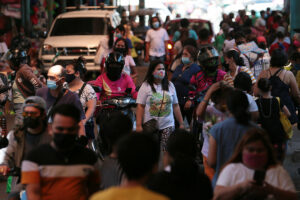THE GOVERNMENT is leaving it to health authorities whether the Philippines should remain under a so-called state of calamity, the presidential palace said on Thursday, amid increasing infections spurred by more contagious Omicron coronavirus subvariants.
“It will depend on the recommendation of the Department of Health (DoH),” Press Secretary Trixie Cruz-Angeles told a news briefing. “We will make the announcement when the time comes,” she added.
The country’s state of calamity declaration will lapse on Sept. 12. The emergency use permits for coronavirus vaccines will also expire unless it is extended.
The state of calamity, which has been extended several times already, allows the government to continue its vaccination program, augment pandemic response funds, monitor and control prices of basic goods and provide basic services to affected people.
Emergency procurement, tax exemptions for donors, price controls for coronavirus drugs and benefits to health workers will also cease once the state of calamity is lifted.
President Ferdinand R. Marcos, Jr. last month ordered health authorities study whether there is a need to extend the declaration.
Meanwhile, Mr. Marcos said state decisions on pandemic response should be based on evidence.
“We can resolve… issues by employing cross-sectoral responsive evidence-based systems,” he told an event attended by scientists and health experts, according to a transcript sent by his office. “Evidence-based systems are all that we rely on.”
The president said the country should always be open to new findings, adding that information about COVID-19 has evolved so quickly.
“We cannot measure this pandemic by any other human experience,” he said. “And that is why we have to be very open and understanding and say… it is not something we already know, it is something that we very much do not know.”
“That is the openness that I speak about, especially whenever groundbreaking data or new findings debunk our usual beliefs,” he added. “This has happened. How many times did it happen during the pandemic where everything changed?”
He said a virology institute and local Center for Disease Control and Prevention would boost the country’s pandemic response. “I have presented to both houses of Congress the proposed creation of the Virology Center of the Philippines… so that we can consolidate in a better way all of the disparate research, all the different sources of knowledge,” he said.
The Philippines is also facing threats from monkeypox, for which the World Health Organization (WHO) declared a global emergency last month.
The Department of Health said 10 close contacts of the country’s first monkeypox case, which was confirmed last month, “are still undergoing the required quarantine period.”
The close contacts have not shown symptoms, it said in a Viber group message. “To date, there has been no new case of monkeypox in the country.”
Health officer-in-charge Maria Rosario S. Vergeire earlier said there should be sufficient immunity among Filipinos before the state of calamity is lifted. She also cited the need to increase booster coverage.
DoH has ordered the Food and Drug Administration to determine whether vaccine makers are ready to apply for a certificate of product registration so the drugs can be sold commercially.
The coronavirus has sickened 3.8 million and killed more than 60,000 people in the Philippines, according to the Worldometers website, citing various sources including data from the WHO. About 3.7 million have recovered from the virus.
There were more than 36,000 active cases, 737 or which were serious or critical.
Globally, the coronavirus has sickened almost 593 million people, killing more than 6.4 million. More than 564 million people have recovered.
At least 71.9 million Filipinos have been fully vaccinated against the coronavirus, with about 16.2 million having received their booster shots.
The Philippines added 3,181 coronavirus infections and 25 deaths on Wednesday.
Of the new infections, 1,100 came from Metro Manila, the Health department said.
The Philippines remained at low risk from the coronavirus despite rising infections, Ms. Vergeire said on Tuesday.
The average daily attack rate was 3.42 cases per 100,000 population, with national and all regions showing increased infections.
The use of intensive care units (ICU) in the country has steadily increased since the start of July, with 772 severe and critical admissions or 19.3% of the total, almost as high as the level in March.
ICU use in the Bangsamoro region was at moderate risk, while four other regions — Calabarzon, Western Visayas, Zamboanga Peninsula and Davao — were near the threshold at more than 40%.
Ms. Vergeire earlier reiterated projections that coronavirus infections in the capital region could hit 11,000 by the end of August.
Cases are expected to rise for the rest of the year if booster uptake remained low, people don’t comply with health standards and are allowed to move more freely, and more Omicron subvariants enter the country. — Norman P. Aquino and Kyle Aristophere T. Atienza

